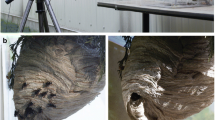Summary
-
1.
Defensive behavior in the social wasp Polybia occidentalis involves two steps: first, in response to jarring of the nest, large numbers of adults are recruited rapidly to the outer surface of the envelope. Second, a fraction of these wasps may fly out to attack the intruder.
-
2.
Observations suggest that the first step, alarm recruitment, is released by a signal given inside the nest. Experimental introduction into the nest of the odors of various glands and body parts show that venom and venom-bearing structures (venom sac, sting apparatus) elicit alarm recruitment that is indistinguishable from that caused by jarring the nest. The wing buzzing that accompanies alarm recruitment is experimentally shown not to communicate alarm.
-
3.
Outside the nest, the odor of venom greatly reduces the threshold for release of attack behavior, but is not itself a releaser of attack. The release of attack behavior requires an appropriate visual stimulus. Dark color of models elicited more attacks than did movement.
Access this article
We’re sorry, something doesn't seem to be working properly.
Please try refreshing the page. If that doesn't work, please contact support so we can address the problem.
Similar content being viewed by others
References
Beier W, Menzel R (1972) Untersuchungen über den Farbensinn der deutschen Wespe (Paravespula germanica F., Hymenoptera, Vespdae): Verhaltensphysiologischer Nachweis des Farbensehens. Zool Jahrb Physiol 76:441–454
Chadab R (1979) Early warning cues for social wasps attacked by amy ants. Psyche 86:115–123
Edwards R (1980) Social wasps, their biology and control. Rentokil, East Grinstead, England
Frisch KV (1967) The dance language and orientation of bees. Harvard University Press, Cambridge, MA
Ikan R, Gottlieb R, Bergmann ED, Ishay J (1969) The pheromone of the queen of the oriental hornet, Vespa orientalis. J Insect Physiol 15:1709–1712
Ishay J (1972) Thermoregulatory pheromones in wasps. Experientia 28:1185–1187
Ishay J (1973) Thermoregulation by social wasps: behavior and pheromones. Trans NY Acad Sci Ser II 35:447–462
Ishay J, Ikan R, Bergmann ED (1965) The presence of pheromones in the oriental hornet, Vespa orientalis F. J Insect Physiol 11:1307–1309
Jeanne RL (1975) The adaptiveness of social wasp nest architecture. Q Rev Biol 50:267–287
Jeanne RL (1979) A latitudinal gradient in rates of ant predation. Ecology 60:1211–1224
Jeanne RL (1980) Evolution of social behavior in the Vespidae. Annu Rev Entomol 25:371–396
Jeanne RL (1981) Chemical communication during swarm emigration in the social wasp Polybia sericea (Olivier). Anim Behav 29:102–113
Kennedy JS (1978) Experimentelle Untersuchung über das Wärmen der Brut bei Vespa crabro und Apis mellifica. Verh Dtsch Zool Ges 1975:148
Maschwitz U (1964) Gefahrenalarmstoffe und Gefahrenalamierung bei sozialen Hymenopteren. Z Vergl Physiol 47:596–655
Naumann MG (1970) The nesting behavior of Protopolybia pumila in Panama (Hymenoptera: Vespidae). Ph D dissertation, University of Kansas, Lawrence
Overal WL, Simões D, Gobbi N (1981) Colony defense and sting autotomy in Polybia rejecta (Hymenoptera: Vespidae). Rev Bras Entomol (Sao Paulo) (in press)
Richards OW (1978) The social wasps of the Americas excluding the Vespinae. British Museum (Natural History), London
Schremmer F (1972) Beobachtungen zur Biologie von Apoica pallida (Olivier, 1791), einer neotropischen sozialen Faltenwespe (Hymenoptera, Vespidae). Insectes Soc 19:343–357
Veith HJ, Koeniger N (1978) Identifizierung von cis-9-Pentacosen als Auslöser für das Wärmen der Brut bei der Hornisse. Naturwissenschaften 65:263
West Eberhard MJ (1969) The social biology of polistine wasps. Misc Publ Mus Zool Univ Mich 140:1–101
Author information
Authors and Affiliations
Rights and permissions
About this article
Cite this article
Jeanne, R.L. Alarm recruitment, attack behavior, and the role of the alarm pheromone in Polybia occidentalis (Hymenoptera: Vespidae). Behav Ecol Sociobiol 9, 143–148 (1981). https://doi.org/10.1007/BF00293585
Received:
Accepted:
Issue Date:
DOI: https://doi.org/10.1007/BF00293585




